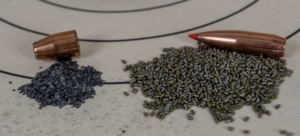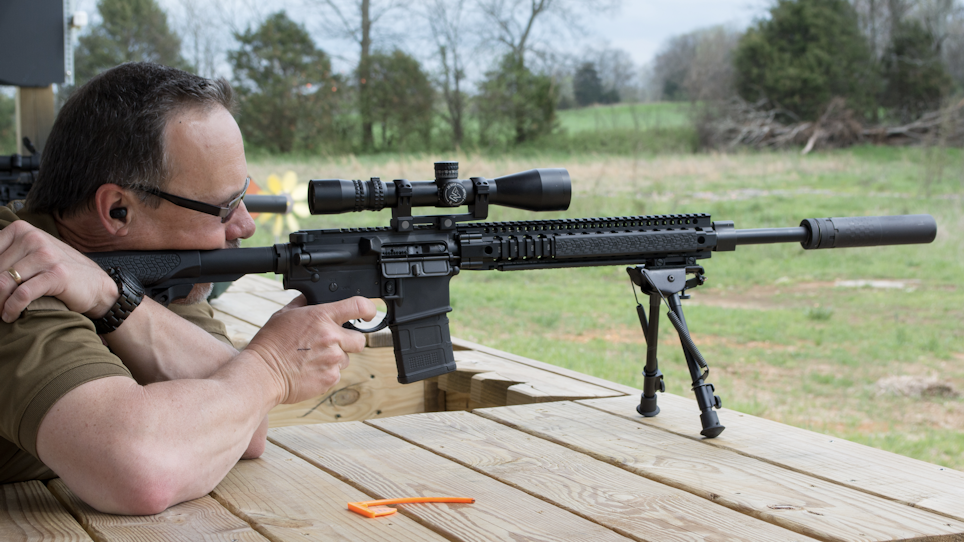For some reason not readily discernible, we gunnies will argue endlessly about the ways in which guns and ammunition can violate the laws of physics.
You know what I mean. We’ve all heard the yarns about the .45 that knocked an enemy combatant 6 feet off the ground and out of their shoes back in (fill in the blank with your conflict of choice here). While that may have happened, it wasn’t the result of physics concepts like the pure momentum of a .45 ACP 230-grain projectile.
Science Rules
What does this have to do with recoil? Wayne’s distant cousin, Isaac Newton came up with this idea that every reaction has an equal and opposite reaction. In his original words, edited for translation, that law reads:

Recoil boils down to Newton's Law that says, in essence, a force in one direction is always opposed by a force in the opposite direction. The combination of powder, bullets, gas, the chamber and exiting the muzzle create recoil felt by the shooter. (Photo: Tom McHale)
To every action there is always opposed an equal reaction: or the mutual actions of two bodies upon each other are always equal, and directed to contrary parts.
In other words, a force in one direction is always opposed by a force in the opposite direction. If you’re sitting in a chair while reading this, your hind side is exerting a downward force on the chair seat. The chair is exerting an upward force on you. Simple enough, right?
With firearms, the same thing happens. The force of the bullet and powder moving forward is opposed by a backward force that pushes the gun towards you. Those two forces have to be equal. In gunny terms, that means that a bullet can’t have more “knockdown” momentum than what exists in recoil. Sure, it can have plenty of “destructive” power, but we’re talking raw momentum here.
In everyday English, that means that if you shoot a .45 bullet at a 175-pound bag of sand or 2003 Chevy Tahoe, neither is going to be knocked over by the bullet. If they were, then the equal and opposite reaction would topple you, the shooter, as well. It’s an immutable law of physics. Without going off the rails in the second paragraph of this article, some of those stories of deer and bad guys flying off their feet might, in fact, be true, but not because of the “knockdown momentum” of the bullet in the literal sense.
Nerves, muscle spasms, fear and a billion other biological factors come into play. Since the shooter didn’t get knocked on their derrière by the shot, neither can their target. Testing this is easy. Just shoot your gun of choice at an inanimate object that’s the same weight as a human or big buck (one with no muscles, nerves or brain) and watch it NOT fall over when hit.
Now back to recoil. Everyone wants power, but it comes at a cost. The more powerful the firearm, the more movement it inflicts on the shooter. That can be not just unpleasant, but the anticipation of that recoil can cause first shot misses. Movement associated with recoil can also cause a delay in follow-up shots. Let’s talk about some important concepts that will help you educate your customers so they can better choose the right handgun, rifle or shotgun. It’s all about finding the right balance between downrange energy and recoil for the job at hand.
What is Recoil?
Simply put, recoil is the movement of the gun opposite the direction of the shot. If you aim forward, recoil forces move backward. That’s simple enough, right? Well, it’s a little more complicated than that.
As defined by the ballistics gurus at SAAMI (Sporting Arms and Ammunition Manufacturers Institute) the calculation to compute free recoil energy is straightforward. You just need to know the mass of the firearm and the velocity with which it’s moving backward towards the shooter. That formula may look familiar from High School physics class.
The trick is to figure out the velocity of the recoiling gun. That depends on how fast all the stuff is going out the fiery end. Now let’s get into figuring out how the bullet moving forward influences the velocity of the gun heading backward during recoil.
Influences on Recoil
Since recoil is ultimately generated by the forward movement of mass, it’s influenced directly by the mass and velocity of the bullet and also by the mass and velocity of the powder charge. Yes, even though the powder is burning like all get out, it’s still got mass, and it’s still moving forward at great velocity, just in a revised physical form.
Things get a little sticky when you factor in the powder charge because it moves at a faster velocity than the bullet. SAAMI and others have developed fudge factors to adjust the recoil calculations based on the type of firearm being measured. For pistols and shotguns, they assume that the powder moves 1.5 times as fast as the bullet. For high-powered rifles, the powder factor is 1.75 times the bullet muzzle velocity. You don’t need to worry too much about this because recoil calculation tools factor this stuff in behind the scenes. We’re only mentioning it here to maintain some semblance of scientific accuracy.
If you want to know the math involved in figuring out the velocity of the firearm, here it is.
The formula looks ugly, but it’s basically calculating the weight and velocity of the bullet, the weight and velocity of the powder charge (adjusted for the fudge factor previously discussed), and dividing all that by the weight of the firearm. The “7,000” number simply handles the conversion of grains to pounds as there are 7,000 grains per pound.
We went through the math for illustration purposes, and if you’re motivated, you can create a spreadsheet that allows you to input the weights and velocities to calculate recoil, or you can do it the easy way and use a handy internet tool. Check out www.shooterscalculator.com.
Gun Weight Matters
If you’ve survived that brief math diversion, you might have noticed that the firearm weight is a direct input to both recoil velocity and recoil energy, so it’s a big deal when considering what the shooter will feel.
Imagine shooting a .338 Lapua Magnum Derringer. Our make believe gun is made from Titanium, so it weighs just 7 ounces. Think you’ll feel the recoil? Now, mount a .22 Long Rifle main gun on an M1 Abrams Tank. Lean your firing shoulder against the back bumper and pull the trigger. Feel any recoil? I’m guessing no. Going back to the original equation, where free recoil energy is determined by the velocity and mass of the “gun.” Because the mass of the tank is enormous, the velocity is going to be zero, hence, no measurable free recoil energy to you the shooter.
In less exaggerated form, the weight difference is one of the reasons that physically larger guns are easier and more pleasant to shoot. Let’s look at a real-world example. Suppose you have a customer choosing between two 9mm pistols, a Springfield Armory XD-E and a Sig Sauer P229 Legion. We’ll shoot the same 124-grain bullet from both pistols, and for example’s sake, we’ll assume that the powder charge weighs 5.5 grains. The 34.4-ounce Sig shoots the bullet at 1,146 feet per second while the shorter and lighter 25-ounce XD-E fires it at 1,073 fps. After doing the recoil math, the Sig generates 4.24 foot-pounds of free recoil energy while the XD-E delivers 5.24 foot-pounds — about 23 percent more.
Velocity Matters
The speed of the recoil impulse also makes a difference, both in the cold and heartless math but also in how recoil feels to the shooter. While some think that the .45 ACP has big recoil for a handgun, it’s never bothered me when compared to most .40s. In fact, I think that the 40 S&W feels like it has much more recoil.
When the human factor, meaning “felt” or “perceived” recoil comes into play, the velocity of the recoil impulse has a lot to do with what we define as “heavy” or “light” recoil.
Practical Applications
Let’s look at the numbers for a few different “full-size” guns in those calibers to see how the free recoil-energy math works out.
Since we’re dealing with different calibers here we’re not making a perfect apples-to-apples comparison, so think of this as a representative caliber comparison where we’ve chosen “standard” loads appropriate for each. Notice the variance when bullet weight, gun weight and velocity all enter the equation.
What about rifles? One of the reasons that people are so enamored with calibers like the 6.5mm Creedmoor is its comparatively light recoil — at least by reputation. So, how do the numbers work out?
Same rifle. Same firearm weight. Different calibers. The difference in free recoil energy between the 6.5mm Creedmoor and .308 Winchester rifles is about 30 percent.
Reducing Recoil
Earlier we discussed how recoil is composed of two different forward-moving components — the bullet and the powder. Let’s look at a specific example to see how much recoil can be mitigated by hardware like muzzle brakes.
One of my handloads is a 6.5mm Creedmoor topped with a 120-grain Hornady A-Max bullet over 44 grains of IMR 4350 powder. That powder mass represents almost 37 percent of the recoil-generating mass. The net-net is this: Don’t discount the powder weight.
Take that information and consider the potential impacts of muzzle brakes. Those are designed to redirect just a portion of the forward-moving gas to the side and/or backward. So, to grossly oversimplify the physics at play, a muzzle brake can only positively impact a portion of a portion of the total recoil force. In other words, it can help reduce (not eliminate) the amount of recoil generated by the burning powder. Brakes can’t do anything about the recoil forces generated by the bullet’s momentum. In round numbers, given that powder charges will differ widely by caliber and projectile choice, you might assume that 30 percent of recoil forces can be affected by a muzzle brake. That doesn’t mean that a brake negates that entire 30 percent. It simply means that 30 percent is “eligible” for some level of reduction.
The other approach to mitigating what the shooter feels is to dampen or slow the recoil impulse. We’re all familiar with shoulder pads on rifles and shotguns. The recoil force is still there; it’s just dampened and slowed as the recoil pad compresses. As with our velocity example, slowing the recoil doesn’t change the total energy, but it does impact our perception of it. Getting slowly pushed off balance by a bully might have the same “free energy” as getting punched in the nose, but one will be perceived rather differently than the other.
The Bottom Line
We did a lot of math in this discussion, but there’s practical application. Once you understand the driving forces behind free recoil energy and shooter perception of the same, you can help steer your customers in the right direction when they choose a firearm.
Everyone wants more power, but that’s not the right question. Assuming that power is adequate for their stated purpose, the next step should involve an evaluation of the “price” they pay for that power. If there is a lower-recoiling option that meets the need, why not explore it?
Fortunately doing the math by hand isn’t a requirement. Using an online recoil calculator will allow you to provide your customers with some comparative, and quantifiable, information about one choice versus another.
Featured image: Tom McHale






